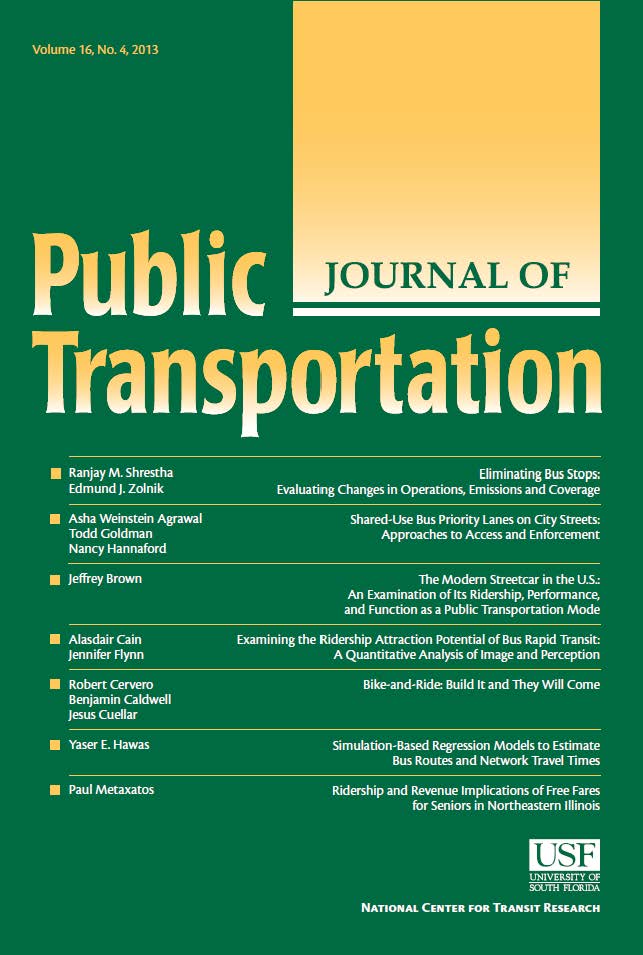The influence of walking accessibility on station-to-station passenger flow and its interaction with metropolitan race/class segregation: A case study of MARTA’s heavy-rail network, Atlanta (USA)
IF 2
4区 工程技术
Q3 TRANSPORTATION
引用次数: 0
Abstract
Mass transit is a key transport strategy in helping cities decarbonize, adapt to an era of rapid climate change, and guide rapid urbanization. Central to transit planning is the ability to accurately estimate demand for an effective, efficient, and equitable infrastructure and services. Instrumental to this effort is direct-demand modelling (DDM), which has evolved to become more nuanced in predicting ridership at station-level and station-to-station levels and in shedding light on key ridership and performance determinants. Local and Metropolitan accessibility as predictors of transit patronage has been shown significant in recent DDM studies at station-level, with an apparent synergistic relationship. This, however, has not been explored on a station-to-station passenger flow level. In several ways this is a more valid unit of analysis for rail ridership studies as it captures critical factors between and at both ends of the trip that are experienced by the passenger. It is also well documented that the sensitivity of passengers to key ridership determinants varies across income levels. In some jurisdictions income level strongly correlates with race/ethnicity and/or class, due in part to historical legacies of classism and/or racism. Segregation because of class and/or race prejudice, often found in US cities, might yield spatial heterogeneity in whole-network DDM model parameters and introduce bias that could potentially mislead transit analysts, policy makers, and systemwide effectiveness. We explored and tested these possibilities and considered modelling and policy implications as we leveraged Atlanta’s legacy of racial and income segregation in studying MARTA’s Origin-Destination (O-D) passenger flow patterns. First, a potential synergistic relationship between origin-stations’ and destination-stations’ walking accessibility levels was tested. Disparities, if any, in this and other ridership determinants were then explored between two distinct sets of O-D pairs whose origin Pedsheds accommodate majority-white or majority-nonwhite residents. Comparison and testing using generalized crossed-effects modelling reveals important differences in fit, magnitude, and significance of some parameters across submodels and as compared to the whole-network model. We also identified distinct moderating effects of distance between O-D pair stations and walking accessibility levels across submodels. In racially- and/or class-segregated cities planners would benefit from developing race- and/or class-based DDM submodels that would likely yield less biassed parameters; improve our understanding of rail transit patronage determinants; and help in crafting more effective and equitable transit and land-use policies.
步行可达性对站间客流的影响及其与大都市种族/阶级隔离的相互作用——以美国亚特兰大MARTA重铁路网为例
公共交通是帮助城市脱碳、适应快速气候变化时代和引导快速城市化的关键交通战略。交通规划的核心是能够准确估计对有效、高效、公平的基础设施和服务的需求。直接需求模型(DDM)对这一努力起到了重要作用,该模型在预测站级和站间客流量以及揭示关键客流量和绩效决定因素方面已经变得更加细致入微。在最近的车站水平的DDM研究中,本地和大都市可达性作为交通惠民的预测因素已被证明是显著的,具有明显的协同关系。然而,这一点还没有在车站到车站的客流水平上进行探讨。从几个方面来说,这是一个更有效的铁路客运量研究分析单位,因为它捕捉到了乘客在旅程之间和两端所经历的关键因素。有充分的证据表明,乘客对主要乘客决定因素的敏感性因收入水平而异。在一些司法管辖区,收入水平与种族/民族和/或阶级密切相关,部分原因是阶级主义和/或种族主义的历史遗产。由于阶级和/或种族偏见而导致的隔离,在美国城市中经常发现,可能会导致全网DDM模型参数的空间异质性,并引入可能误导交通分析师、政策制定者和系统范围有效性的偏见。我们探索和测试了这些可能性,并考虑了建模和政策影响,因为我们利用亚特兰大的种族和收入隔离遗产来研究MARTA的始发目的地(O-D)客流模式。首先,对起点站和终点站步行可达性水平之间的潜在协同关系进行了测试。然后,研究人员在两组不同的O-D对之间探讨了这一和其他乘客决定因素的差异(如果有的话),这两组O-D对的起源社区容纳了多数白人或多数非白人居民。使用广义交叉效应模型进行比较和测试,揭示了与整个网络模型相比,某些参数在子模型之间的拟合、幅度和显著性方面存在重要差异。我们还发现了不同子模型之间O-D对站之间的距离对步行可达性水平的显著调节作用。在种族和/或阶级隔离的城市,规划者将受益于开发基于种族和/或阶级的DDM子模型,这些子模型可能产生较少偏见的参数;提高我们对轨道交通乘客决定因素的理解;并帮助制定更有效和公平的交通和土地使用政策。
本文章由计算机程序翻译,如有差异,请以英文原文为准。
求助全文
约1分钟内获得全文
求助全文
来源期刊

Journal of Public Transportation
TRANSPORTATION-
CiteScore
6.40
自引率
0.00%
发文量
29
审稿时长
26 days
期刊介绍:
The Journal of Public Transportation, affiliated with the Center for Urban Transportation Research, is an international peer-reviewed open access journal focused on various forms of public transportation. It publishes original research from diverse academic disciplines, including engineering, economics, planning, and policy, emphasizing innovative solutions to transportation challenges. Content covers mobility services available to the general public, such as line-based services and shared fleets, offering insights beneficial to passengers, agencies, service providers, and communities.
 求助内容:
求助内容: 应助结果提醒方式:
应助结果提醒方式:


